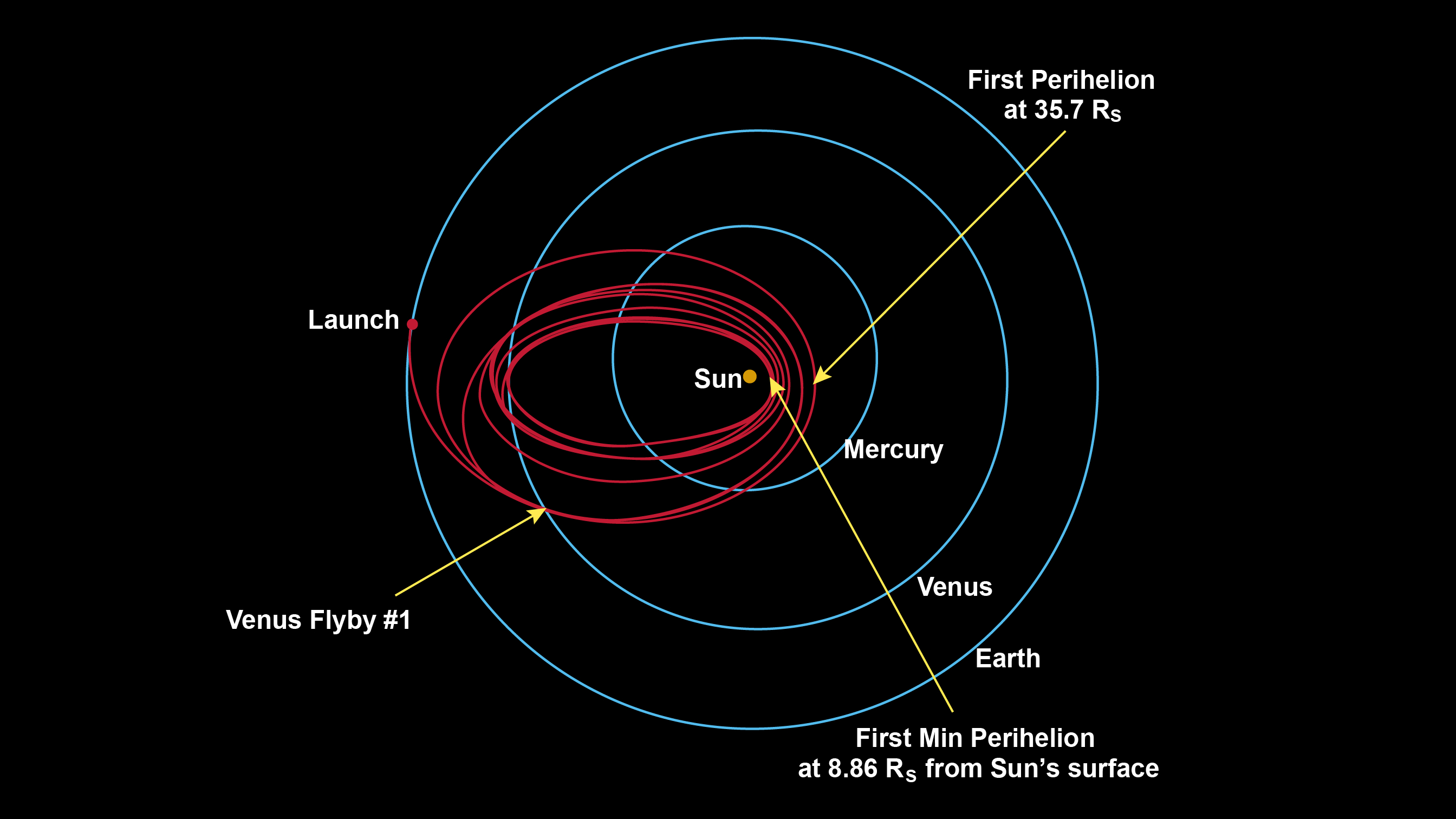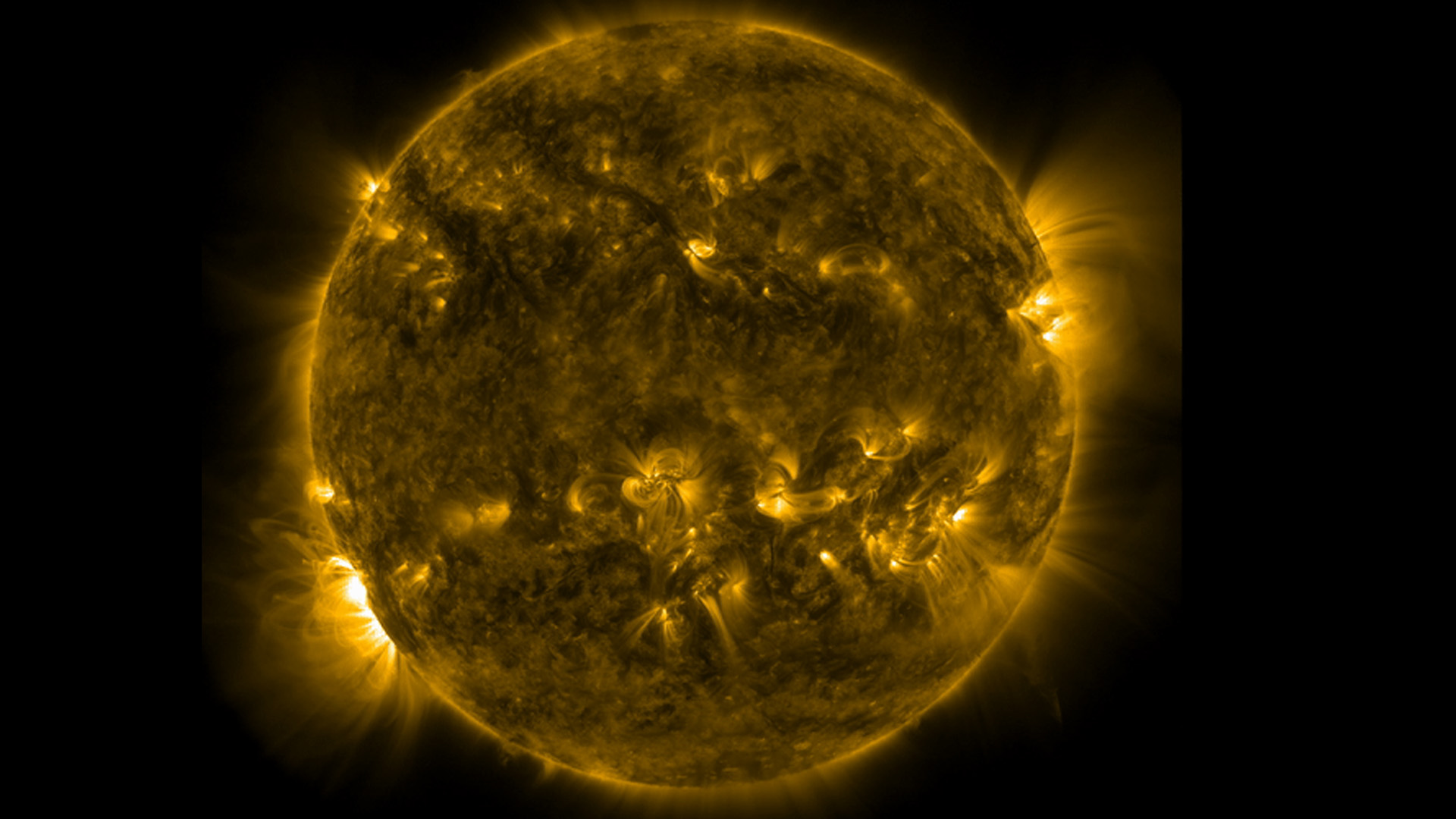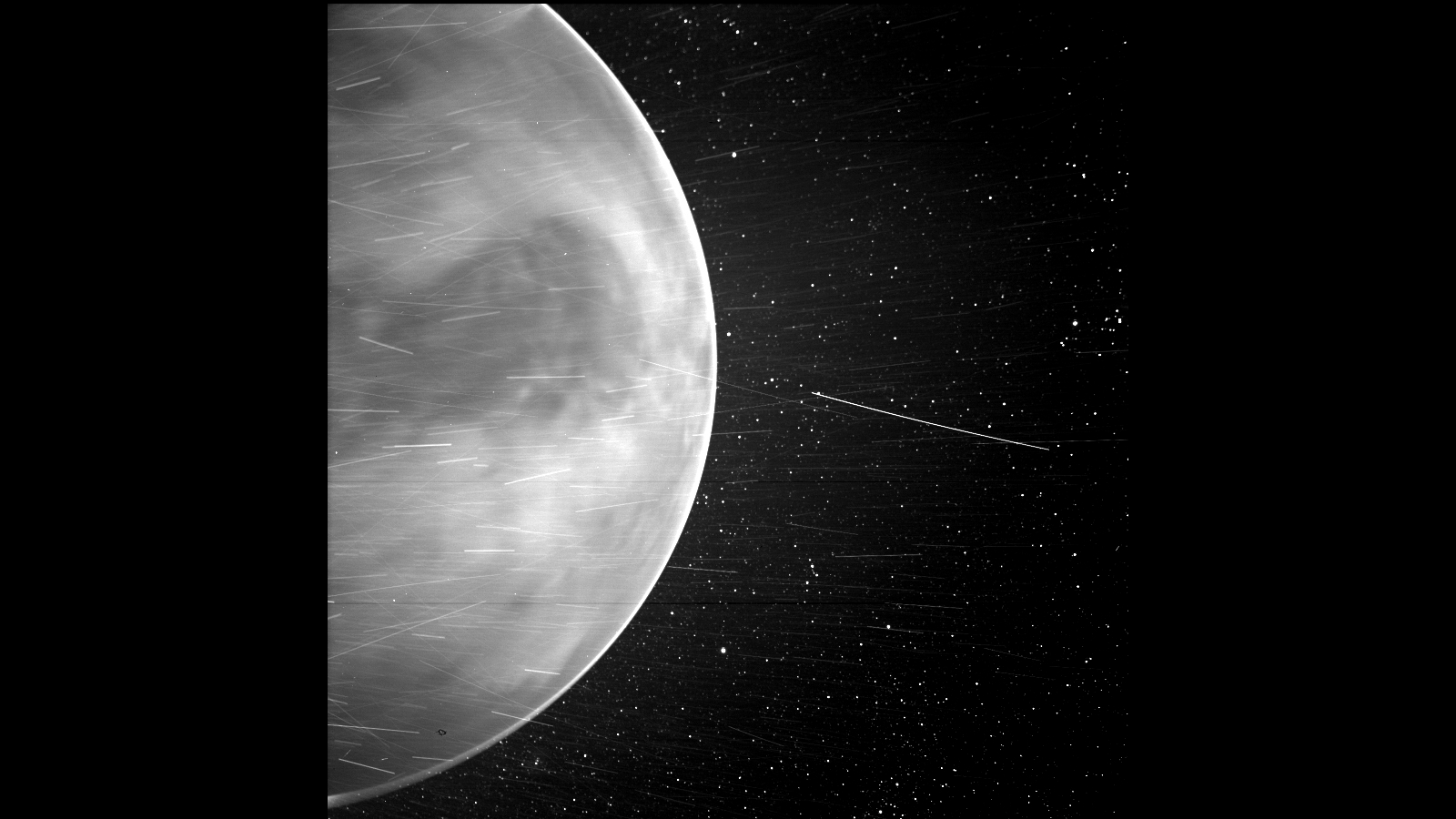Parker Solar Probe: First spacecraft to 'touch' the sun
NASA's Parker Solar Probe is a modern-day Icarus, embarking on a daring sungrazing mission.

NASA's Parker Solar Probe launched on Aug. 12, 2018, aboard a United Launch Alliance Delta IV Heavy rocket. The Parker Solar Probe's mission is to study the sun in unprecedented detail.
The revolutionary solar probe became the first spacecraft to "touch" the sun when it swooped inside the sun's outer atmosphere, or corona, during its eighth flyby on April 28, 2021, according to a statement from NASA. The probe will complete 24 orbits of the sun over its seven-year lifespan and fly seven times closer to our star than any other spacecraft.
The Parker Solar Probe's closest approach to the sun will occur on Dec. 24, 2024, during which the spacecraft will swoop to within 3.8 million miles of the solar surface.
The Parker Solar Probe is named after pioneering astrophysicist Eugene Parker, who first proposed the existence of solar wind in 1958, according to the European Space Agency (ESA). Parker visited the probe during its construction and witnessed its launch, in doing so becoming the first person to ever witness the liftoff of their namesake spacecraft. Prof. Emeritus Eugene N. Parker died on March 15, 2022, at the age of 94.
"Parker Solar Probe is going to answer questions about solar physics that we've puzzled over for more than six decades," Parker Solar Probe Project Scientist Nicola Fox, of The Johns Hopkins University Applied Physics Laboratory (APL), said in a statement.
"It's a spacecraft loaded with technological breakthroughs that will solve many of the largest mysteries about our star, including finding out why the sun's corona is so much hotter than its surface. And we're very proud to be able to carry Gene's name with us on this amazing voyage of discovery."
Related: How hot is the sun?
Breaking space news, the latest updates on rocket launches, skywatching events and more!
Parker Solar Probe speed
On Sept. 27, 2023, the sun's powerful gravity accelerated the probe to a top speed blistering 394,736 mph/ (635,266 km/h)That's faster than any probe had ever traveled before.
Parker Solar Probe trajectory
The Parker Solar Probe has flown closer to the sun than any other spacecraft and will continue to shrink its orbit around our star over its approximately seven-year lifespan.
The solar probe's swooping trajectory around the sun would not be possible without a series of Venus gravity assist flybys. Over its lifetime, the probe will use seven Venus flybys to gradually narrow its orbit around the sun, coming as close as 3.83 million miles (6.16 million km) — more than seven times closer than Mercury gets to our star, according to the APL.
Parker Solar Probe temperature
When the probe makes its closest approach to the sun, its solar shields will encounter temperatures approaching 2,600 degrees Fahrenheit (1,400 degrees Celsius), according to APL.
Astonishingly, the spacecraft's science instruments will be protected from these scorching temperatures and remain close to room temperature — about 85 degrees F (30 degrees C).
Parker Solar Probe objectives
The Parker Solar Probe is studying the sun up close and personal in a bid to understand how energy and heat move through the sun's atmosphere and affect processes such as the solar wind.
According to APL, the three main scientific objectives of the Parker Solar Probe are:
- Trace the flow of energy that heats and accelerates the solar corona and solar wind.
- Determine the structure and dynamics of the plasma and magnetic fields at the sources of the solar wind.
- Explore mechanisms that accelerate and transport energetic particles.
The sun is the primary source of Earth's light and heat, but that's not the only way it affects the planet. The solar wind is a collection of charged particles that stream from the star and flow past Earth at speeds of more than a million mph (400 kilometers per second), according to NASA. Disturbances in the solar wind can shake our planet's magnetic field and pump energy into the radiation belts, triggering a set of changes known as space weather.
Space weather is significantly affected by the solar wind and other solar outbursts such as solar flares and coronal mass ejections. During times of peak activity — when the solar cycle is at solar maximum — space weather can pose a risk to communications on Earth, satellites and even spacewalking astronauts.
The Parker Solar Probe is helping scientists understand more about the sun's underlying mechanisms so they can improve space forecasting efforts and be more prepared for changes in solar activity.
"Until we can explain what is going on up close to the sun, we will not be able to accurately predict space weather effects that can cause havoc at Earth," says the APL Parker Solar Probe website.
Parker solar probe instruments
The spacecraft carries four instruments:
The Solar Wind Electrons Alphas and Protons Investigation (SWEAP) counts the most abundant particles in the solar wind, measuring the properties of electrons, protons and helium ions.
The Wide-field Imager for Solar Probe Plus (WISPR) is a telescope that makes three-dimensional images of the sun's corona and inner heliosphere to actually "see" the solar wind and provide 3D images of shocks and other structures as they travel past the spacecraft. When flying past Venus in 2020, the WISPR instrument detected a bright rim surrounding the planet. Scientists suggest it may be a phenomenon known as nightglow caused by "light emitted by oxygen atoms high in the atmosphere that recombine into molecules in the nightside" NASA officials said in a description of the image.
The Electromagnetic Fields Investigation (FIELDS) makes direct measurements of the shock waves that course through the sun's atmospheric plasma.
The Integrated Science Investigation of the Sun (IS◉IS) consists of two instruments that will take an inventory of the elements in the solar atmosphere by using a mass spectrometer to study charged particles near the probe.
Eugene Newman Parker legacy
In the 1950s, Eugene Newman Parker, an astrophysicist at the University of Chicago, proposed several concepts about how stars — including our sun — give off energy. He described an entire complex system of plasmas, magnetic fields and magnetic particles that make up what he referred to as the solar wind, the cascade of energy streaming from the sun.
Originally, the mission was billed as Solar Probe Plus. But in 2017, only a few days before the scientist's 90th birthday, NASA renamed the mission to honor Parker for his contributions.
"This is the first time NASA has named a spacecraft for a living individual," Thomas Zurbuchen, associate administrator for NASA's Science Mission Directorate in Washington, said in a statement. "It's a testament to the importance of his body of work, founding a new field of science that also inspired my research and many important science questions NASA continues to study and further understand every day. I'm very excited to be personally involved honoring a great man and his unprecedented legacy."
Most NASA missions are renamed after their launch and certification. However, in this case, the decision was made to honor Parker before the launch, to draw attention to his important contributions to heliophysics and space science.
Originally proposed in 1958, the mission has been a long time in coming, "not because we weren't excited," Fox told reporters before the 2018 launch, "but because we had to wait 60 years for technology to catch up with our dreams."
"The solar probe is going to a region of space that has never been explored before," said Parker. "It's very exciting that we'll finally get a look. One would like to have some more detailed measurements of what's going on in the solar wind. I'm sure that there will be some surprises. There always are."
On Aug. 12, 2018, Parker became the first person to ever witness the launch of their namesake spacecraft. In addition, Parker received numerous awards for his research and significant contributions to science, including the George Ellery Hale Prize, the National Medal of Science, the Bruce Medal, the Gold Medal of the Royal Astronomical Society, the Kyoto Prize, the James Clerk Maxwell Prize and the Crafoord Prize in Astronomy, according to his NASA biography.
Pioneering astrophysicist Prof. Emeritus Eugene N. Parker died on March 15, 2022, aged 94, according to a statement released by the University of Chicago.
"The university and the department has lost one of its giants," said Michael Turner, the Bruce V. and Diana M. Rauner Distinguished Service Professor Emeritus of Astronomy and Astrophysics at the University of Chicago and a colleague of Parker's for decades. "Gene changed the course of science with his work on magnetic fields literally everywhere in the cosmos, but he remained humble and approachable, with a wry sense of humor."
Additional resources
Learn more about the Parker Solar Probe mission with this NASA press kit. Explore the solar probe's instruments with a series of short videos from APL. Read what NASA scientist Kelly Korreck has to say about what it takes to be a solar scientist. Check out ESA's Solar Orbiter and learn more about its solar orbiting mission with these resources from ESA.
Bibliography
Johnson-Groh, M. (2021, December 13). NASA enters the solar atmosphere for the first time. NASA. Retrieved May 5, 2022.
Teamwork with Parker Solar Probe. ESA. (2019, October 7). Retrieved May 5, 2022.
Brown, G. (2017, May 31). Solar Probe Mission renamed to honor pioneering physicist. NASA. Retrieved May 5, 2022.
NASA. (2021, December 14). In-depth: Parker Solar Probe. NASA. Retrieved May 5, 2022.
NASA Parker Solar Probe: The Mission. The John Hopkins University Applied Physics Laboratory. Retrieved May 5, 2022.
Buckley, M. (2021, February 24). Parker Solar Probe offers stunning view of Venus. NASA. Retrieved May 5, 2022.
Garner, R. (2021, February 8). Eugene Newman Parker. NASA. Retrieved May 5, 2022, from A NASA biography article.

Daisy Dobrijevic joined Space.com in February 2022 having previously worked for our sister publication All About Space magazine as a staff writer. Before joining us, Daisy completed an editorial internship with the BBC Sky at Night Magazine and worked at the National Space Centre in Leicester, U.K., where she enjoyed communicating space science to the public. In 2021, Daisy completed a PhD in plant physiology and also holds a Master's in Environmental Science, she is currently based in Nottingham, U.K. Daisy is passionate about all things space, with a penchant for solar activity and space weather. She has a strong interest in astrotourism and loves nothing more than a good northern lights chase!
- Nola Taylor TillmanContributing Writer





